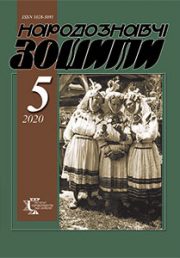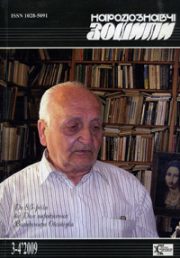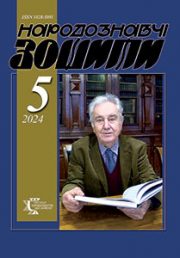The Ethnology Notebooks. 2021. # 1 (157), P. 98—110
УДК 94(=512.19:560)”1980/2000″
DOI https://doi.org/10.15407/nz2021.01.098
Rustem ABLÂTİFOV
- ORCID ID: https://orcid.org/0000-0002-3368-7203
- Master in Public Administration, Ph. D. candidate,
- Ivan Franko National University of Lviv,
- Department of Middle Ages and Byzantine Studies,
- 1, Universitetska Str., 79000, Lviv, Ukraine,
- e-mail: abu-bakr@ukr.net
Problem statement. The Qırımlı National Movement appeared as a historical phenomenon as a movement to restore their rights and freedoms, first of all, for the right to return to their historical Motherland — Crimea in the USSR in the middle of the 1950’s. The movement arose mainly in the Central Asian republics, where the Qırımlı nation was deported extrajudicially and totally by Stalin’s regime in 1944. As a result of this criminal Deportation that has been recognized by the parliaments of Ukraine, Latvia and Lithuania as an act of genocide against the Qırımlı, 46,2% of deportees died in consequence of the transportation in non-human terms and extrajudicial executions, slave labour, abuse and diseases, during the first two years of the exile. The Qırımlı National Movement is a unique precedent in the world history, since the whole nation was involved on the principles of the non-violent struggle for their own rights in the conditions of the USSR totalitarian regime. Beginning from the period of the so-called «Khrushchev thaw», the Crimean diaspora’s representatives in the Western states are joined also to the struggle for the right to return to their Motherland.
The purpose of this study is to research and to analyse a role and place of the Turkey’s Crimean diaspora in the Qırımlı national movement during their mass repatriation process to the Autonomous Republic of Crimea’s territory from the former exile places in a period of the end of 1980s to the early 2000s, the Turkish Crimean diaspora’s influence and contribution to the common struggle to restore the Qırımlı nation rights and freedoms. Also, an attention is paid to the influence of the Qırımlı national and cultural associations on the public policy of the Turkish Republic to support the process of the Qırımlı repatriation to their historical Homeland. The scientific novelty is that activities of the Turkey’s Crimean diaspora within the framework of the activity of the Qırımlı national movement and its contribution to the struggle for the Qırımlı right to return to their historical Motherland are studied for the first time. Research methods are based on the principles of systemicity and historicism. One of the main methods is also the method of «oral history», when the sources of information were specially conducted interviews. Conclusions. The Crimean diaspora’s movement in Turkey joined the national Qırımlı movement and made its important contribution to the struggle to return to the Qırımlı nation to their historical Motherland and to revive their culture and spirituality in the late 1990s.
Keywords: Qırımlı diaspora, Crimea, Turkey, Qırımlı national movement, return
REFERENCES
- Arabaci, H.M. (2006). The importance of the Crimean associations and foundations in Turkey in the view of the Turkic history and culture. PhD thesis. The History Department, the Institute of Social Sciences, the Istanbul University. Istanbul. Retrieved from: http://nek.istanbul.edu.tr:4444/ekos/TEZ/41902.pdf (Last accessed: 04.10.2019) [in Turkish].
- Aydin, F.T. (2012). Comparative Cases in Long-Distance Nationalism: Explaining Emirgre, Exile, Diaspora and Transnational Movements of the Crimean Tatars. PhD thesis. Department of Political Science, the University of Toronto. Toronto. Retrieved from: https://tspace.library.utoronto.ca/bitstream/1807/67253/1/Aydin_Filiz_T_201211_PhD_thesis.pdf (Last accessed: 23.06.2018).
- Omelchenko, G. (2009). How they did not open a criminal case on the genocide against the Crimean Tatar nation. Analitika (Analytics) (Part of 3). Retrieved from: http://analitica.kiev.ua/invest/extra/7469-yak-ne-hotli-porushuvati-krimnalnu-spravu-schodo-genocidu-krimskotatarskogo-narodu-chastina-3.html (Last accessed: 24.07.2019) [in Ukrainian].
- Ablyatifov, R.M. (2019). The Crimean diaspora on the territory of the modern Turkey: from the annexation of Crimea to the World War II. East European Review on Contemporary Issues, 1 (Vol. 1). Retrieved from: https://journals.indexcopernicus.com/api/file/viewByFileId/624163.pdf (Last accessed: 11.09.2019) [in Ukrainian].
- Karpat, K. (1985). Ottoman Population 1830—1914. Demographic and Social Characteristics. University of Madison-Wisconsin.
- Safran, W. (1991, spring). Diasporas in Modern Societies: Myths of Homeland and Return. Diaspora: A Journal of Transnational Studies, 1 (Vol. 1, pp. 83–99). Retrieved from: http://europeofdiasporas.eu/sites/default/files/posts/ files/3.%20Safran%20Diasporas%20in%20Modern%20Society.pdf (Last accessed: 10.08.2019).
- Safa Giray. Wikipedia. Retrieved from: https://en.wikipedia.org/wiki/Safa_Giray (Last accessed: 24.07.2019).
- Eren, N., & Allwourth, E.A. (Ed.). (1998). Crimean Tatar communities abroad. In: The Tatars of Crimea. Return to the Homeland. Duke University Press, Durham and London.
- History. The official page of the Istanbul branch of the Association of culture and mutual aid of the Crimean Turks. Retrieved from: http://istanbulkirim.org/hakkimizda/tarihce/ (Last accessed: 04.04.19) [in Turkish].
- Memorandum of the association. The official page of the Istanbul branch of the Association of culture and mutual aid of the Crimean Turks. Retrieved from: http://istanbulkirim.org/hakkimizda/tuzuk/ (Last accessed: 04.04.19) [in Turkish].
- About the organization. The official page of the Association of culture and mutual aid of the Crimean Turks. Retrieved from: http://www.kirimdernegi.org.tr/dernek/teskilat (Last accessed: 09.07.2019) [in Turkish].
- The official page of the Association of culture and mutual aid of the Crimean Turks of Eskişehir. Retrieved from: http://kocaelikirim.org/ (Last accessed: 09.07.2019) [in Turkish].
- The official page of the Emel Foundation for Researches and Promotion of the Turkic culture. Retrieved from: http://emelvakfi.org/ (Last accessed: 16.04.2019) [in Turkish].
- Mustecip Ulkusal. Wikipedia. Retrieved from: https://tr.wikipedia.org/wiki/Mustecip_Ulkusal (Last accessed: 23.06.2019) [in Ukrainian].
- About the Crimean Emel Foundation. The official page of the Emel Foundation for Researches and Promotion of the Turkic culture. Retrieved from: http://emelvakfi.org/emel-kirim-vakfi-hakkinda/ (Last accessed: 16.04.19) [in Turkish].
- Mustafa Dzhemilev. Wikipedia. Retrieved from: https://en.wikipedia.org/wiki/Mustafa_Dzhemilev (Last accessed: 16.04.19) [in Ukrainian].
- Ulkusal, M. (1976). The Crimean martyr Mustafa Cemiloglu. Emel (The Aspiration), 93, 3—4 [in Turkish].
- Toprak, F. (2013). Perception of Homeland Among Crimean Tatar Diaspor Living in Turkey as Reflected on the Diaspora Journal Emel. Thesis for a Master of Science. The Department of Eurasian Studies, Middle East Technical University. Retrieved from: http://ansamblperegrinus.pl/uploads/artykuly/perception_of_homeland_among_crimean_tatar_diaspora_living_in_turkey_feyza_toprak.pdf (Last accessed: 23.06.19).
- (1992). Return our home. Emel (The Aspiration), 3—4, 41—49 [in Turkish].
- Reddaway, P., & Allwourth, E.A. (Ed.). (1998). The Crimean Tatar drive for repatriation. In: The Tatars of Crimea. Return to the Homeland. Duke University Press, Durham and London.
- Guboglo, M.N., & Chervonnaya, S.M. (1992). The Crimean Tatar movement. History. Problems. Prospects (Vol. 1). Moscow: Perspektivy [in Russian].
- Chervonnaya, S.M. (1996). The Crimean Tatar national movement. Retrieved from: http://tatar-history.narod.ru/krim-tatar.htm (Last accessed: 24.06.19) [in Russian].
- Bulgarisation. Wikipedia. Retrieved from: https://en.wikipedia.org/wiki/Bulgarisation (Last accessed: 25.07.2019).
- Kahraman, A. (2014). The Crimean Tatar National Movement in the publications of inner and outer diaspora: Lenin Bayragı, Emel and Dergi. Thesis for a Master of Science. The Department of Eurasian Studies, Middle East Technical University. Retrieved from: http://etd.lib.metu.edu.tr/upload/12617563/index.pdf (Last accessed: 15.07.2019).
- (1989). Turkish journalists are in Crimea. Emel (The Aspiration), 175, 55—56 [in Turkish].
- Mejlis of the Crimean Tatar people. Wikipedia. Retrieved from: https://en.wikipedia.org/wiki/Mejlis_of_the_Crimean_Tatar_People (Last accessed: 15.07.2019) [in Ukrainian].
- Qurultay of the Crimean Tatar people. Wikipedia. Retrieved from: https://en.wikipedia.org/wiki/Qurultay_of_the_Crimean_Tatar_People (Last accessed: 15.07.2019) [in Ukrainian].
- Qalga. Wikipedia. Retrieved from: https://tr.wikipedia.org/wiki/Kalgay (Last accessed: 15.07.2019) [in Ukrainian].
- (2005). Bahchesaray, 34, 2 [in Turkish].
- Yuksel, G.Z. (2014). The modern mass media of the Crimean Tatar diaspora: aspect of functionality. The Cultures of peoples of the Black Sea region, 274, 68—71 [in Russian].
- (1994). TRT-2 demonstrates «Crimea’s documentary». Emel (The Aspiration), 201, 44—45 [in Turkish].
- Ahmed Ihsan Kyrymly. Wikipedia. Retrieved from: https://en.wikipedia.org/wiki/Ahmed_Ihsan_Kırımlı (Last accessed: 02.02.19) [in Ukrainian].
- Karatay, Z. (1992). Visit of the Chairman of the Majlis of Crimean Tatar nation and delegation of the Majlis to Turkey. Emel (The Aspiration), 188, 1—32 [in Turkish].
- Necati Ozensoy. Wikipedia. Retrieved from: https://tr.wikipedia.org/wiki/Necati_%C3%96zensoy (Last accessed: 02.08.2019) [in Ukrainian].
- (2000). The Ambassador of Ukraine was our guest. Kyrym Postasy (The Crimean Post), 10, 5 [in Turkish].
- (2014). The Crimean activities of the TASD going on. Retrieved from: https://3dkonut.com/tikanin-kirimdaki-faaliyetleri-devam-ediyor/haberi (Last accessed: 17.06.2019) [in Turkish].
- (2012). To the 20th anniversary of the Kyiv-92 action. Retrieved from: https://avdet.org/ru/2012/03/26/k-20-letiyu-aktsii-kiev-92-2/ (Last accessed: 29.07.2019) [in Russian].






